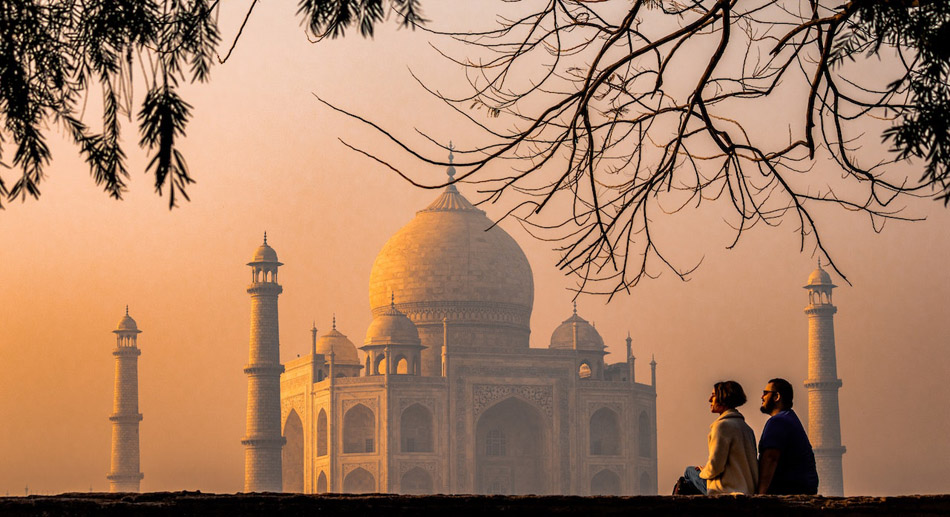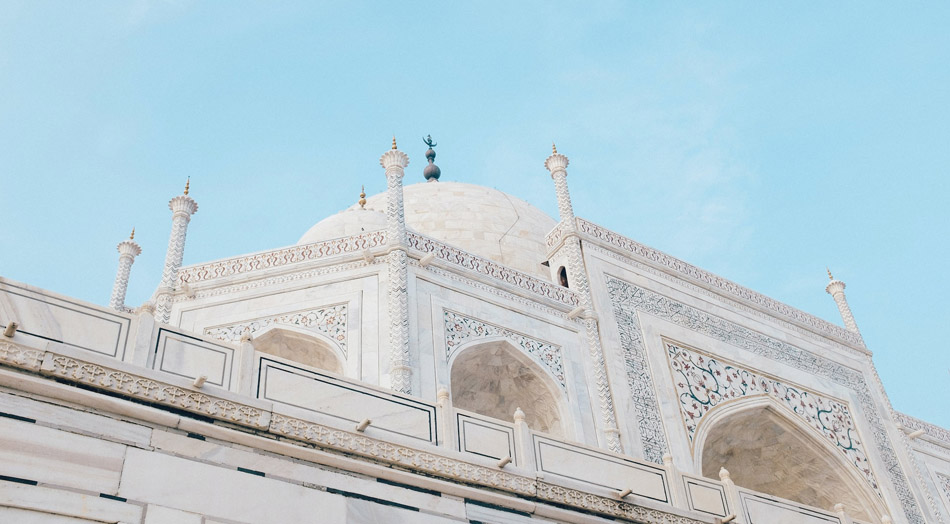The Taj is an iconic monument symbolizing deep love, attachment, and memories for one’s beloved. Shah Jahan was a Mughal emperor of the 17th century who had great love, admiration, and fondness for his wife Mumtaz Mahal. She died in 1631 while giving birth to their 14th child. The king became so distraught at her sudden demise that he decided to preserve her memories for all time by building a grand mausoleum complex in her name. Little did the king know then that his precious gesture of love for his beloved wife would be later lauded as a stunning piece of Persian/Mughal art and architecture, will be tagged as a world heritage site, and feature as one of the greatest wonders of the world!
The Taj Mahal is often, and rightly, described as the ‘earthly replica of paradise to embody Shah Jahan and Mumtaz Mahal’s perfect love.’ Shah Jahan soon got working to give vision to his grand project. The construction of the Taj began seven months after Mumtaz Mahal’s death, and thousands of skilled craftsmen and artisans of the best caliber were employed to give fruition to his vision. Royal architects were engaged to plan, execute, and supervise the workings of this project which was to take shape on an ambitious scale.
Built in the bustling, imperial city of Agra in the state of Uttar Pradesh, India, Taj Mahal is about 230 kilometers away from the national capital New Delhi. It is located on the banks of the river Yamuna. The riverfront was an ideal location as it was already dotted with exquisite residences at the time and surrounded by beautiful gardens and mausoleums. It took more than 2 decades for the workers and artisans to finally complete the Taj. It was completed in 1653. The final product was a magnificent piece of art and engineering that would leave visitors completely awestruck!
Today, the Taj Mahal is one of the seven wonders of the world and attracts millions of tourists not only from India but from all over the world.
Facts About the Taj Mahal

- A Symbol of Love: The Taj Mahal is considered one of the most romantic monuments in the world, and is a testament to the deep love and devotion the Mughal Emperor, Shah Jahan, had for his wife. No wonder, it attracts droves of newly-wedded and young couples to the premises every year as they get inspired by the historical story of the undying love of the king for his beloved empress.
- A Masterpiece of Architecture: Taj Mahal is one of a kind. It is considered a masterpiece of architecture that beautifully integrates the Persian, Islamic, Indian, and European styles. It is a true work of art as it has intricate carvings and designs with inlaid precious stones all over the place. Most of the structures were built with brick and red sandstone. The main component used in its construction is white marble, which symbolizes spiritual purity. The king had sourced it from various locations in India. The walls are covered with quranic inscriptions and calligraphy. In short, the Taj is the culmination of the Mughal architectural achievement.
- A Mausoleum Complex: Mumtaz Mahal is buried here, and Shah Jahan is buried next to her inside the mausoleum. Besides the royal tombs, the complex also houses a mosque, a guesthouse, and a beautiful stretch of garden dotted with a select variety of flowers and trees to add color and sweet scent to the ambiance. There are pools, walkways, and channels of water that weave through the lush greenery inside the historical complex.
- A UNESCO World Heritage Site: The Taj Mahal has captured the imagination and hearts of people for generations now, and continues to inspire more. It is a timeless symbol of love and a marvelous piece of Mughal architecture that seamlessly blends elements of Indian, Persian, Turkish, and European architectural traditions. It is both a UNESCO World Heritage Site and one of the seven wonders of the world. Given its historical, architectural, and cultural significance, it was declared a UNESCO World Heritage Site in 1983.
- A Popular Tourist Destination: The Taj Mahal continues to be one of the most visited tourist destinations in India, attracting millions of visitors from all over the world. People marvel at the stunning white marble, elegant calligraphy, and intricate carvings that make the Taj one of the most recognizable buildings in the world. The historical structure drives and promotes the state’s tourism. The Indian government has taken active measures to preserve and protect this timeless piece of beauty for posterity to enjoy and appreciate for years to come.
Myths About the Taj Mahal

The following are some myths about this dignified structure:
- The British Built the Taj: For the uninitiated, the Taj Mahal was built by the Mughal emperor, Shah Jahan, in memory of his loving wife, Mumtaz Mahal in the 17th century. It was not built by the British as is popularly believed by certain sections of people. The British were yet to make their foray into Indian territory.
- The Taj is Made Entirely of Marble: Though the Taj Mahal stands out because of its marble minarets and dome, the building is actually made of a combination of materials like bricks, red sandstone, and precious stones. The interior corridors are made of jade, jasper, and other materials. All of these were sourced from different parts of the world. Another interesting rumor that frequently gets mentioned is that Shah Jahan had ordered his men to dismember the hands of the 20,000 workers and craftsmen who worked on this ambitious project so that they do not create a replica. This claim is completely baseless and there is no historical proof to support this theory.
- Taj is a Palace: The Taj Mahal is a grand and epic structure that stands out in history because of its elegance and intricacies. It is a monumental piece of art and architecture with elaborate designs that may have the semblance of a palace, but in reality, it is a mausoleum. It is the final resting place of Shah Jahan’s beloved wife, Mumtaz Mahal, and houses her remains. The Taj Mahal was never intended to be used as a palace.
- The Taj Mahal is Falling Apart: The entire team of the Archaeological Survey of India (ASI) works very hard to protect, preserve, and maintain the interiors and exteriors of this World Heritage Site that receives heavy footfall on a daily basis. It works diligently to restore the decayed and disintegrated portions of the edifice so that the mausoleum and its precincts can be kept open for public view for generations to come. Despite its age and thanks to the efforts of the ASI, the Taj Mahal is in relatively good condition. Some parts of the building have suffered from the effects of weathering and air pollution, but it has also undergone extensive restoration and preservation efforts over the years.
- Taj Mahal is a Temple: According to the most recent controversy, the Taj Mahal is a temple. People subscribing to this view wanted the Archaeological Survey of India (ASI) to look into the 22 closed rooms inside the Taj to check if statues and figures of Hindu gods were kept inside. According to this theory, the Taj Mahal is actually a Hindu Shiva temple by the name Tejo Mahalaya. This theory was later trashed by the apex court of the country. Even according to the ASI, these rooms are not rooms per se, rather they were installed for aesthetic reasons along an extended corridor. Hence, that the Taj Mahal is a Hindu temple is just another myth that has been broken in recent times.

